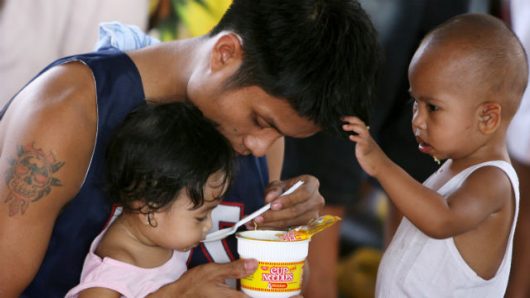Eliminating Hunger In The Philippines: More Than Just Food Aid

Despite an increase in the rate of employment (by about 5 percent), poverty in the Philippines has seen relatively no improvement. The Philippine Statistics Authority (PSA) conducted research in order to guide policymakers in their efforts to alleviate hunger in the Philippines.
In 2015, 17.2 percent of the population lived under the poverty threshold.
Amado Parawan is the health and nutrition advisor for an organization called Save the Children. He recently urged Filipino presidential candidates to re-evaluate their methodologies to address hunger in the Philippines.
Parawan stated that feeding programs are really only a “band-aid solution” to solving the infection of hunger and malnutrition. In addition, he encouraged them to seek foreign aid and consult experts on globally accepted intervention policies.
His plea to candidates follows a recent initiative by Save the Children Philippines called the ‘Lahat Dapat’ campaign. This movement highlights the importance of healthcare in the prenatal and early stages of development for Filipino children.
Current foreign initiatives include the World Food Programme (WFP) of the U.N., which began their work in 1968. However, they had to reestablish their presence in 2006, after the government requested more aid in light of increasing armed conflict.
The program focuses on improving food insecurity and helping communities to build resilience in preparing for natural disasters. In addition, the program also emphasizes the importance of providing healthy meals for children in school.
Each school year, over 65,000 children in the areas of Lanao del Sur, Lanao del Norte and Maguindanao receive crucial nourishment school meals. Good nutrition then increases school retention rates, as well as the quality of the education children receive.
Additionally, Action Against Hunger works to eliminate hunger in the Philippines. Armed conflicts have displaced many Filipinos. One such area is Zamboanga, where efforts have been directed towards providing clean water, sanitation, and nutrition education.
The government of the Philippines is known for its $450-million conditional cash transfer program, Pantawid Pamilyang Pilipino Program. It also recently received a new financing package from the World Bank. This social safety net program helps to reduce the vulnerability of families to sudden economic difficulties. The money ensures that children receive ample nutrition and access to education. It also gives pregnant mothers access to regular health exams.
By assessing the methodologies that have been successful in other nations and modifying them to fit the Philippines’ unique needs, the partnership of the government and the international community established a successful food aid program.
The most important consideration when working to eliminate hunger in the Philippines is fostering independence. Humanitarian organizations and the governments involved will not only provide food, but they will also help families become self-sufficient.
If aid continues to be this sustainable and organizations continue to educate households about efficient and healthy lifestyles, Filipinos will develop their own economy and reduce hunger in the process.
– Veronica Ung-Kono
Photo: Rappler
